Online Library for Study Material with Solved Assignments - Desklib
VerifiedAdded on 2023/06/11
|12
|2383
|286
AI Summary
This content provides a brief explanation of different types of business organizations, six main users of accounting information, journal entries in the books of David, general ledger of Kelvin Co, trial balance as at 30 Sep 2021, and income statement in the books of S. Brown as at 30th December 2021.
Contribute Materials
Your contribution can guide someone’s learning journey. Share your
documents today.
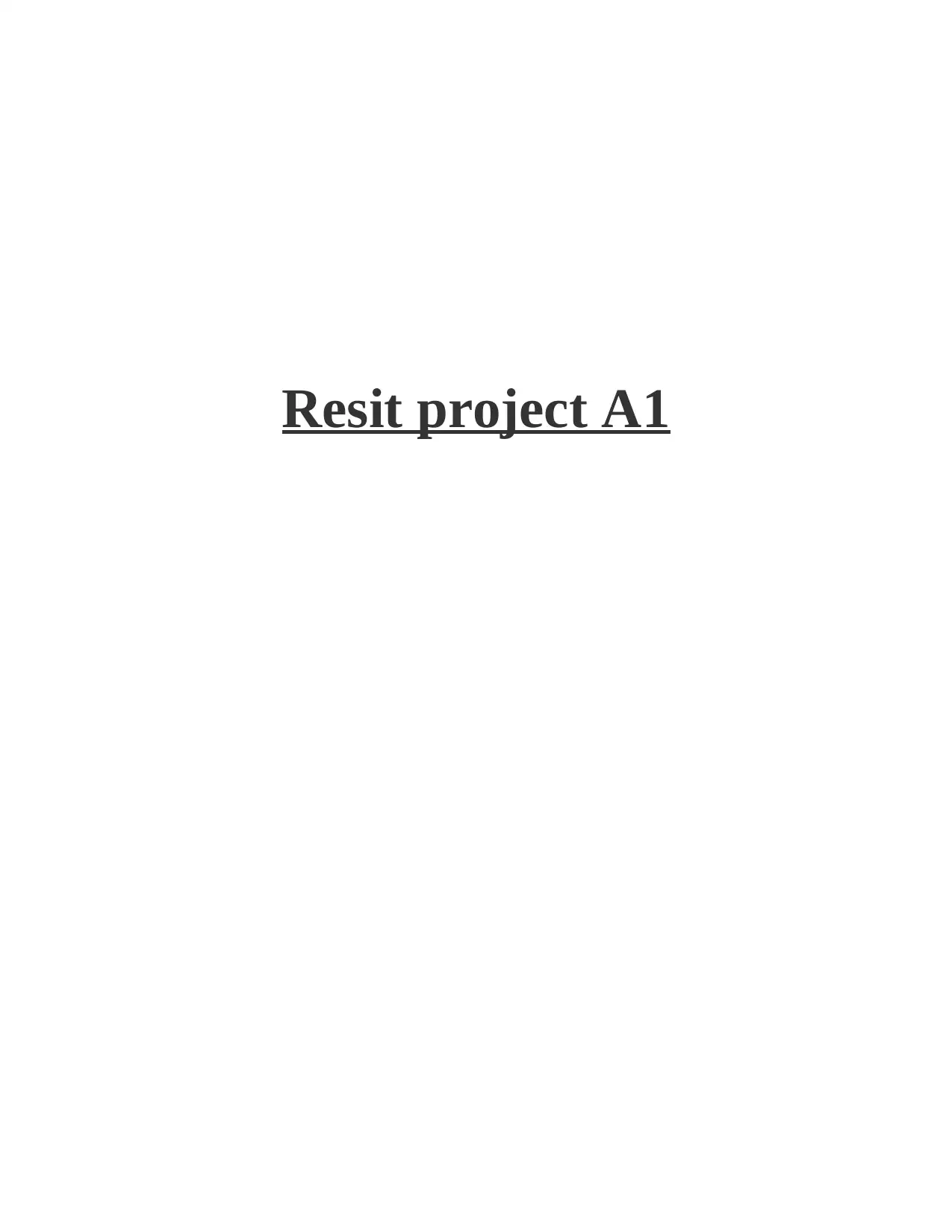
Resit project A1
Secure Best Marks with AI Grader
Need help grading? Try our AI Grader for instant feedback on your assignments.
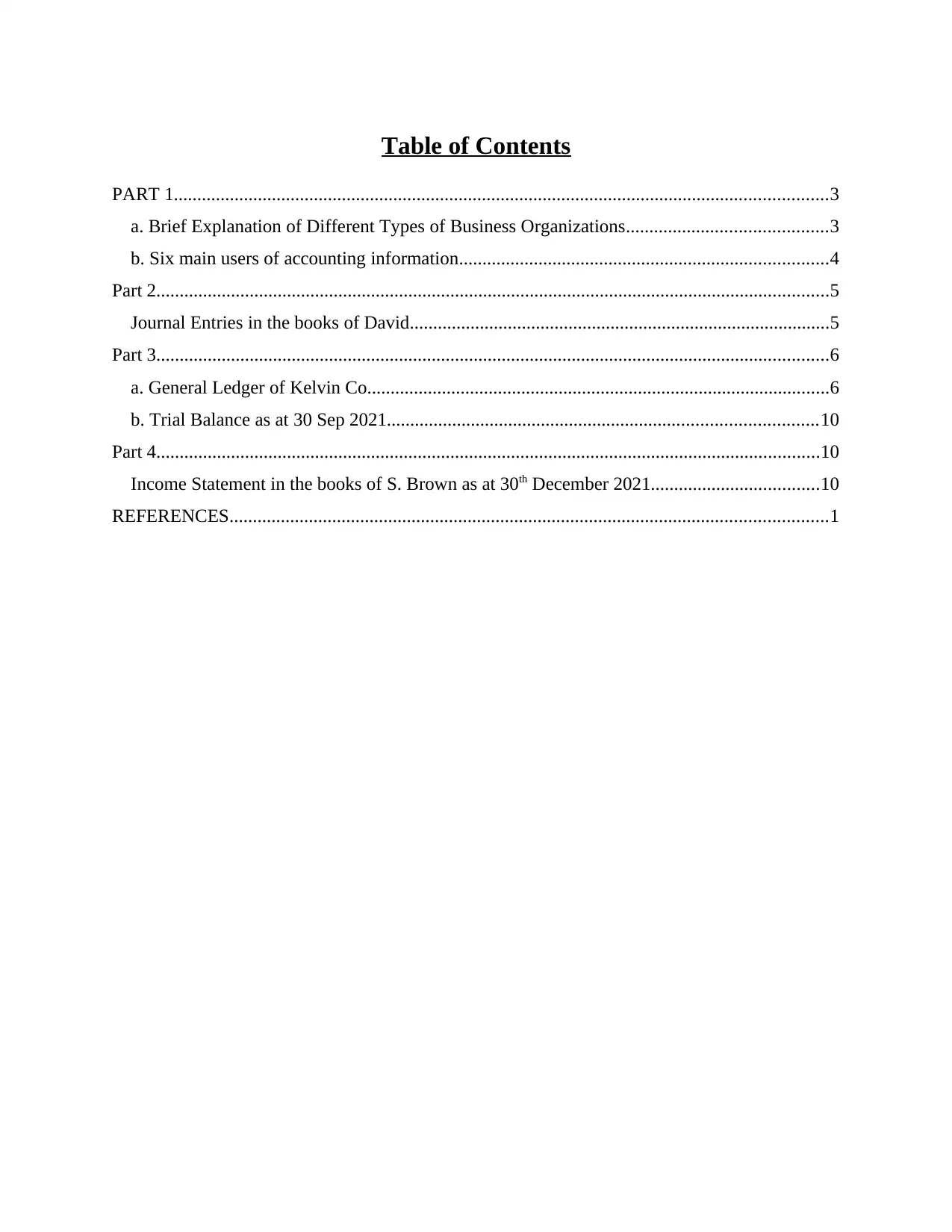
Table of Contents
PART 1............................................................................................................................................3
a. Brief Explanation of Different Types of Business Organizations...........................................3
b. Six main users of accounting information...............................................................................4
Part 2................................................................................................................................................5
Journal Entries in the books of David..........................................................................................5
Part 3................................................................................................................................................6
a. General Ledger of Kelvin Co...................................................................................................6
b. Trial Balance as at 30 Sep 2021............................................................................................10
Part 4..............................................................................................................................................10
Income Statement in the books of S. Brown as at 30th December 2021....................................10
REFERENCES................................................................................................................................1
PART 1............................................................................................................................................3
a. Brief Explanation of Different Types of Business Organizations...........................................3
b. Six main users of accounting information...............................................................................4
Part 2................................................................................................................................................5
Journal Entries in the books of David..........................................................................................5
Part 3................................................................................................................................................6
a. General Ledger of Kelvin Co...................................................................................................6
b. Trial Balance as at 30 Sep 2021............................................................................................10
Part 4..............................................................................................................................................10
Income Statement in the books of S. Brown as at 30th December 2021....................................10
REFERENCES................................................................................................................................1
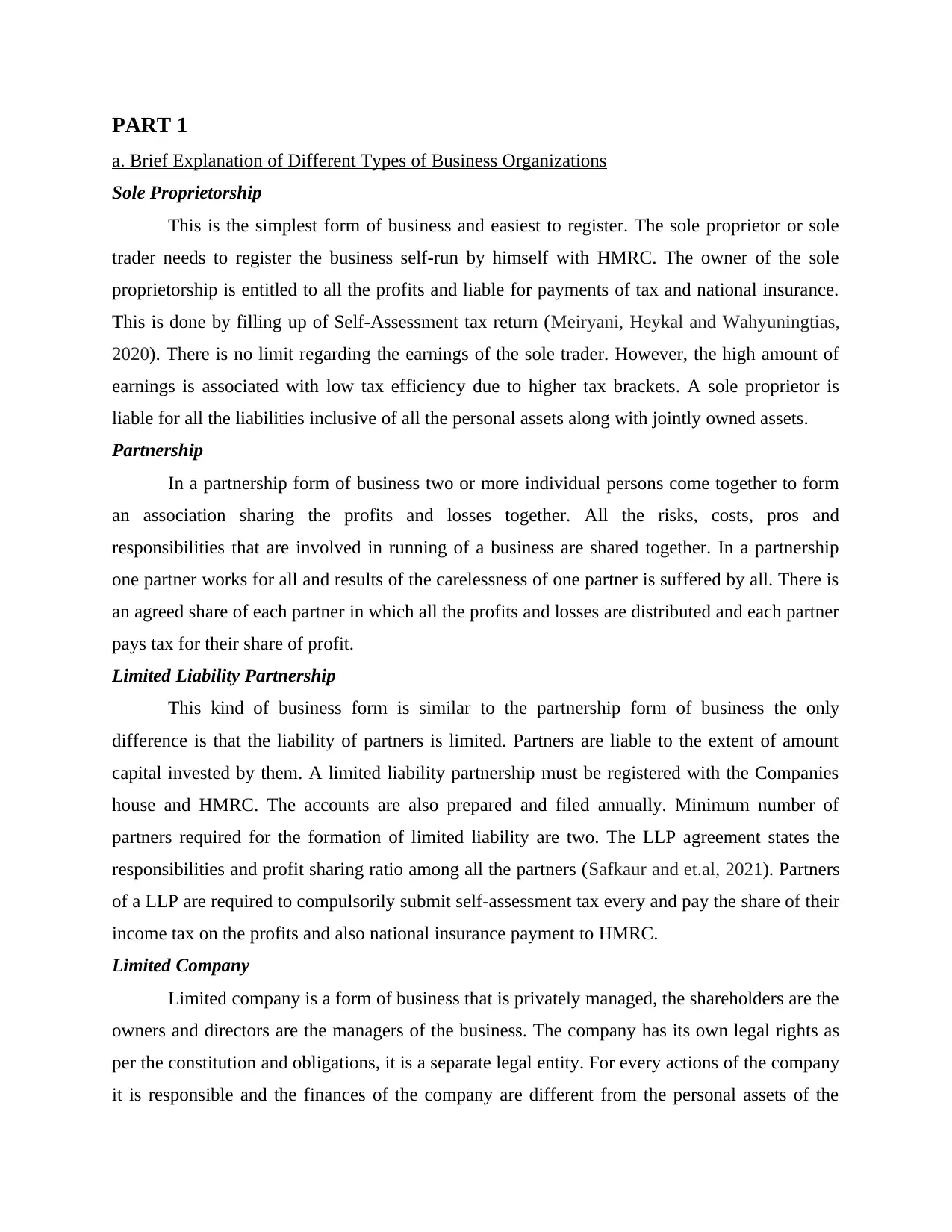
PART 1
a. Brief Explanation of Different Types of Business Organizations
Sole Proprietorship
This is the simplest form of business and easiest to register. The sole proprietor or sole
trader needs to register the business self-run by himself with HMRC. The owner of the sole
proprietorship is entitled to all the profits and liable for payments of tax and national insurance.
This is done by filling up of Self-Assessment tax return (Meiryani, Heykal and Wahyuningtias,
2020). There is no limit regarding the earnings of the sole trader. However, the high amount of
earnings is associated with low tax efficiency due to higher tax brackets. A sole proprietor is
liable for all the liabilities inclusive of all the personal assets along with jointly owned assets.
Partnership
In a partnership form of business two or more individual persons come together to form
an association sharing the profits and losses together. All the risks, costs, pros and
responsibilities that are involved in running of a business are shared together. In a partnership
one partner works for all and results of the carelessness of one partner is suffered by all. There is
an agreed share of each partner in which all the profits and losses are distributed and each partner
pays tax for their share of profit.
Limited Liability Partnership
This kind of business form is similar to the partnership form of business the only
difference is that the liability of partners is limited. Partners are liable to the extent of amount
capital invested by them. A limited liability partnership must be registered with the Companies
house and HMRC. The accounts are also prepared and filed annually. Minimum number of
partners required for the formation of limited liability are two. The LLP agreement states the
responsibilities and profit sharing ratio among all the partners (Safkaur and et.al, 2021). Partners
of a LLP are required to compulsorily submit self-assessment tax every and pay the share of their
income tax on the profits and also national insurance payment to HMRC.
Limited Company
Limited company is a form of business that is privately managed, the shareholders are the
owners and directors are the managers of the business. The company has its own legal rights as
per the constitution and obligations, it is a separate legal entity. For every actions of the company
it is responsible and the finances of the company are different from the personal assets of the
a. Brief Explanation of Different Types of Business Organizations
Sole Proprietorship
This is the simplest form of business and easiest to register. The sole proprietor or sole
trader needs to register the business self-run by himself with HMRC. The owner of the sole
proprietorship is entitled to all the profits and liable for payments of tax and national insurance.
This is done by filling up of Self-Assessment tax return (Meiryani, Heykal and Wahyuningtias,
2020). There is no limit regarding the earnings of the sole trader. However, the high amount of
earnings is associated with low tax efficiency due to higher tax brackets. A sole proprietor is
liable for all the liabilities inclusive of all the personal assets along with jointly owned assets.
Partnership
In a partnership form of business two or more individual persons come together to form
an association sharing the profits and losses together. All the risks, costs, pros and
responsibilities that are involved in running of a business are shared together. In a partnership
one partner works for all and results of the carelessness of one partner is suffered by all. There is
an agreed share of each partner in which all the profits and losses are distributed and each partner
pays tax for their share of profit.
Limited Liability Partnership
This kind of business form is similar to the partnership form of business the only
difference is that the liability of partners is limited. Partners are liable to the extent of amount
capital invested by them. A limited liability partnership must be registered with the Companies
house and HMRC. The accounts are also prepared and filed annually. Minimum number of
partners required for the formation of limited liability are two. The LLP agreement states the
responsibilities and profit sharing ratio among all the partners (Safkaur and et.al, 2021). Partners
of a LLP are required to compulsorily submit self-assessment tax every and pay the share of their
income tax on the profits and also national insurance payment to HMRC.
Limited Company
Limited company is a form of business that is privately managed, the shareholders are the
owners and directors are the managers of the business. The company has its own legal rights as
per the constitution and obligations, it is a separate legal entity. For every actions of the company
it is responsible and the finances of the company are different from the personal assets of the
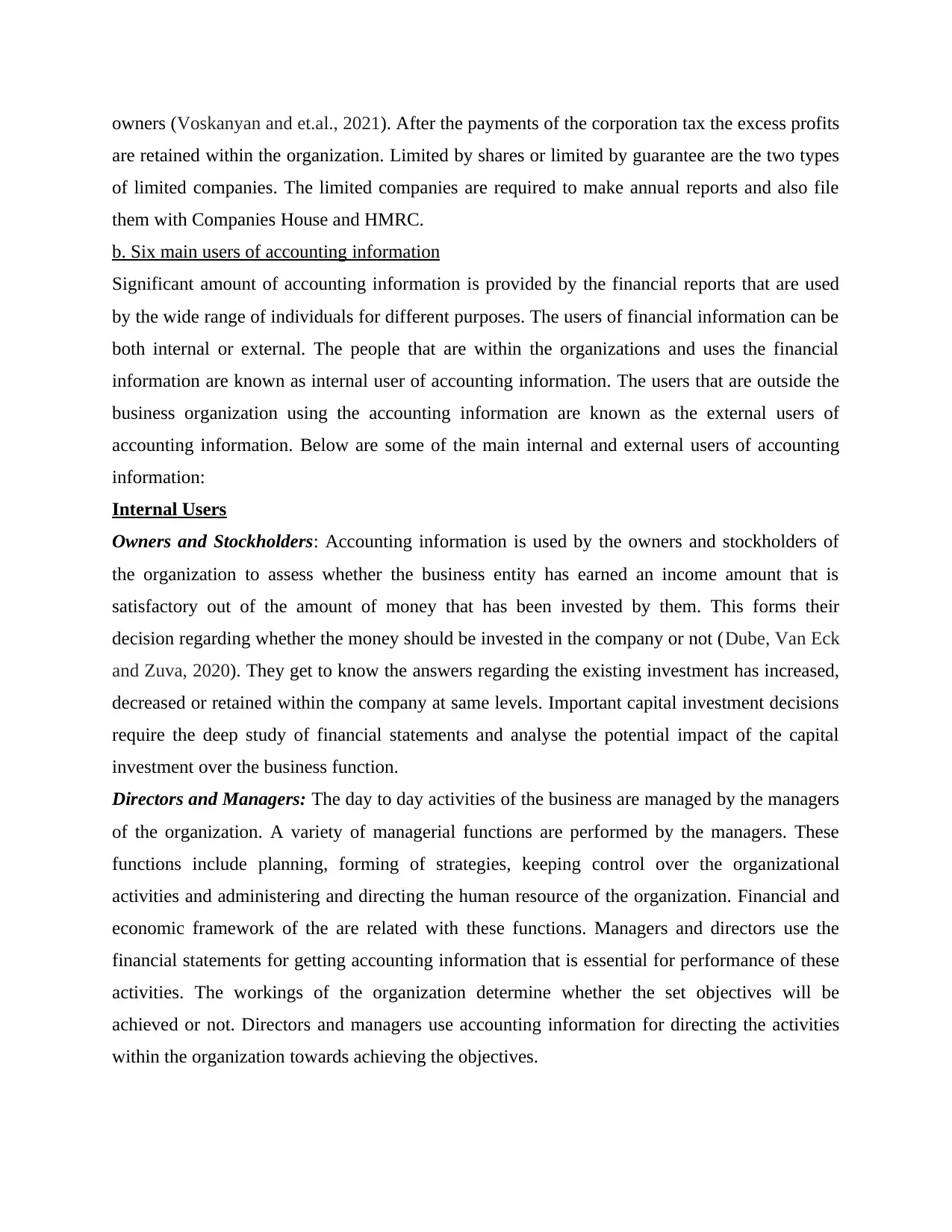
owners (Voskanyan and et.al., 2021). After the payments of the corporation tax the excess profits
are retained within the organization. Limited by shares or limited by guarantee are the two types
of limited companies. The limited companies are required to make annual reports and also file
them with Companies House and HMRC.
b. Six main users of accounting information
Significant amount of accounting information is provided by the financial reports that are used
by the wide range of individuals for different purposes. The users of financial information can be
both internal or external. The people that are within the organizations and uses the financial
information are known as internal user of accounting information. The users that are outside the
business organization using the accounting information are known as the external users of
accounting information. Below are some of the main internal and external users of accounting
information:
Internal Users
Owners and Stockholders: Accounting information is used by the owners and stockholders of
the organization to assess whether the business entity has earned an income amount that is
satisfactory out of the amount of money that has been invested by them. This forms their
decision regarding whether the money should be invested in the company or not (Dube, Van Eck
and Zuva, 2020). They get to know the answers regarding the existing investment has increased,
decreased or retained within the company at same levels. Important capital investment decisions
require the deep study of financial statements and analyse the potential impact of the capital
investment over the business function.
Directors and Managers: The day to day activities of the business are managed by the managers
of the organization. A variety of managerial functions are performed by the managers. These
functions include planning, forming of strategies, keeping control over the organizational
activities and administering and directing the human resource of the organization. Financial and
economic framework of the are related with these functions. Managers and directors use the
financial statements for getting accounting information that is essential for performance of these
activities. The workings of the organization determine whether the set objectives will be
achieved or not. Directors and managers use accounting information for directing the activities
within the organization towards achieving the objectives.
are retained within the organization. Limited by shares or limited by guarantee are the two types
of limited companies. The limited companies are required to make annual reports and also file
them with Companies House and HMRC.
b. Six main users of accounting information
Significant amount of accounting information is provided by the financial reports that are used
by the wide range of individuals for different purposes. The users of financial information can be
both internal or external. The people that are within the organizations and uses the financial
information are known as internal user of accounting information. The users that are outside the
business organization using the accounting information are known as the external users of
accounting information. Below are some of the main internal and external users of accounting
information:
Internal Users
Owners and Stockholders: Accounting information is used by the owners and stockholders of
the organization to assess whether the business entity has earned an income amount that is
satisfactory out of the amount of money that has been invested by them. This forms their
decision regarding whether the money should be invested in the company or not (Dube, Van Eck
and Zuva, 2020). They get to know the answers regarding the existing investment has increased,
decreased or retained within the company at same levels. Important capital investment decisions
require the deep study of financial statements and analyse the potential impact of the capital
investment over the business function.
Directors and Managers: The day to day activities of the business are managed by the managers
of the organization. A variety of managerial functions are performed by the managers. These
functions include planning, forming of strategies, keeping control over the organizational
activities and administering and directing the human resource of the organization. Financial and
economic framework of the are related with these functions. Managers and directors use the
financial statements for getting accounting information that is essential for performance of these
activities. The workings of the organization determine whether the set objectives will be
achieved or not. Directors and managers use accounting information for directing the activities
within the organization towards achieving the objectives.
Secure Best Marks with AI Grader
Need help grading? Try our AI Grader for instant feedback on your assignments.
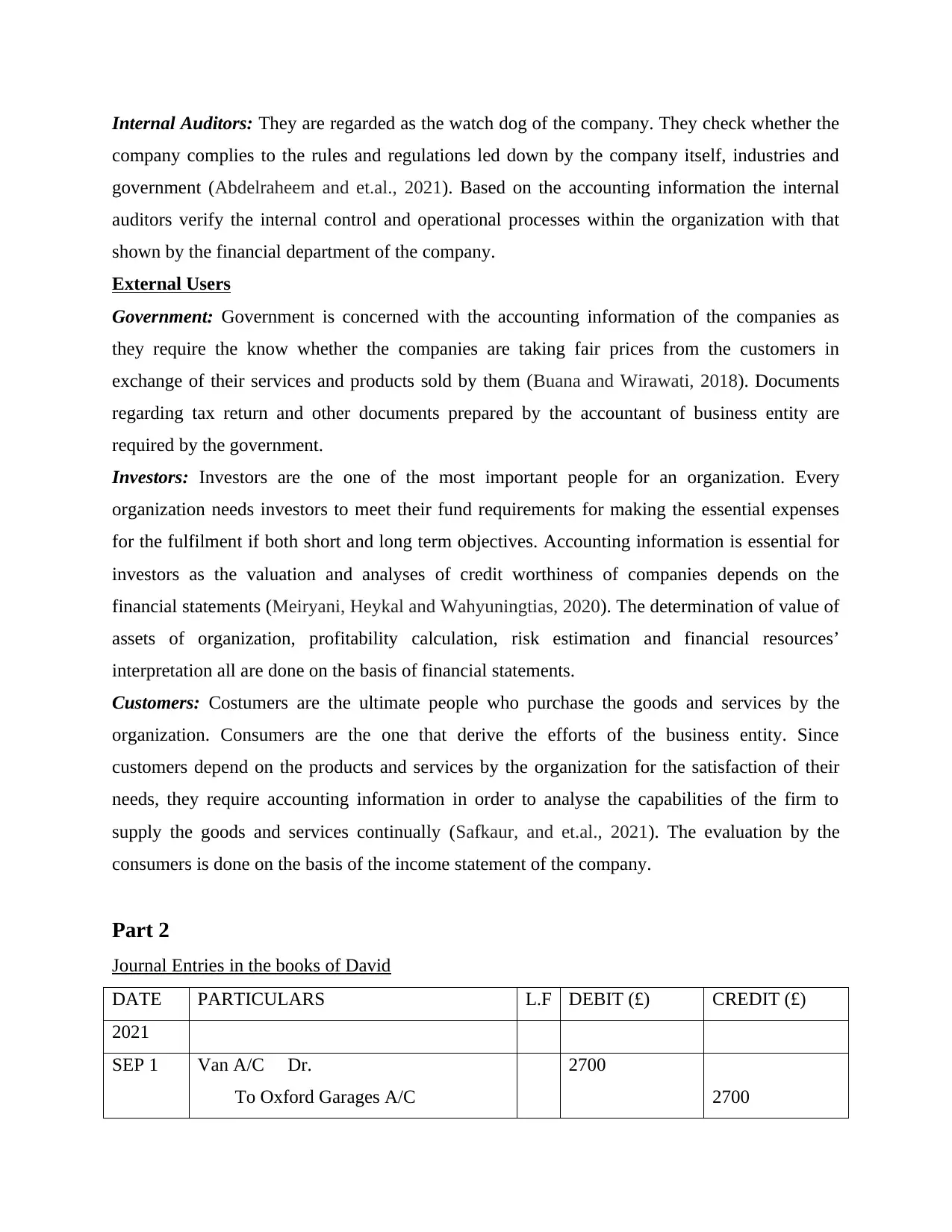
Internal Auditors: They are regarded as the watch dog of the company. They check whether the
company complies to the rules and regulations led down by the company itself, industries and
government (Abdelraheem and et.al., 2021). Based on the accounting information the internal
auditors verify the internal control and operational processes within the organization with that
shown by the financial department of the company.
External Users
Government: Government is concerned with the accounting information of the companies as
they require the know whether the companies are taking fair prices from the customers in
exchange of their services and products sold by them (Buana and Wirawati, 2018). Documents
regarding tax return and other documents prepared by the accountant of business entity are
required by the government.
Investors: Investors are the one of the most important people for an organization. Every
organization needs investors to meet their fund requirements for making the essential expenses
for the fulfilment if both short and long term objectives. Accounting information is essential for
investors as the valuation and analyses of credit worthiness of companies depends on the
financial statements (Meiryani, Heykal and Wahyuningtias, 2020). The determination of value of
assets of organization, profitability calculation, risk estimation and financial resources’
interpretation all are done on the basis of financial statements.
Customers: Costumers are the ultimate people who purchase the goods and services by the
organization. Consumers are the one that derive the efforts of the business entity. Since
customers depend on the products and services by the organization for the satisfaction of their
needs, they require accounting information in order to analyse the capabilities of the firm to
supply the goods and services continually (Safkaur, and et.al., 2021). The evaluation by the
consumers is done on the basis of the income statement of the company.
Part 2
Journal Entries in the books of David
DATE PARTICULARS L.F DEBIT (£) CREDIT (£)
2021
SEP 1 Van A/C Dr.
To Oxford Garages A/C
2700
2700
company complies to the rules and regulations led down by the company itself, industries and
government (Abdelraheem and et.al., 2021). Based on the accounting information the internal
auditors verify the internal control and operational processes within the organization with that
shown by the financial department of the company.
External Users
Government: Government is concerned with the accounting information of the companies as
they require the know whether the companies are taking fair prices from the customers in
exchange of their services and products sold by them (Buana and Wirawati, 2018). Documents
regarding tax return and other documents prepared by the accountant of business entity are
required by the government.
Investors: Investors are the one of the most important people for an organization. Every
organization needs investors to meet their fund requirements for making the essential expenses
for the fulfilment if both short and long term objectives. Accounting information is essential for
investors as the valuation and analyses of credit worthiness of companies depends on the
financial statements (Meiryani, Heykal and Wahyuningtias, 2020). The determination of value of
assets of organization, profitability calculation, risk estimation and financial resources’
interpretation all are done on the basis of financial statements.
Customers: Costumers are the ultimate people who purchase the goods and services by the
organization. Consumers are the one that derive the efforts of the business entity. Since
customers depend on the products and services by the organization for the satisfaction of their
needs, they require accounting information in order to analyse the capabilities of the firm to
supply the goods and services continually (Safkaur, and et.al., 2021). The evaluation by the
consumers is done on the basis of the income statement of the company.
Part 2
Journal Entries in the books of David
DATE PARTICULARS L.F DEBIT (£) CREDIT (£)
2021
SEP 1 Van A/C Dr.
To Oxford Garages A/C
2700
2700
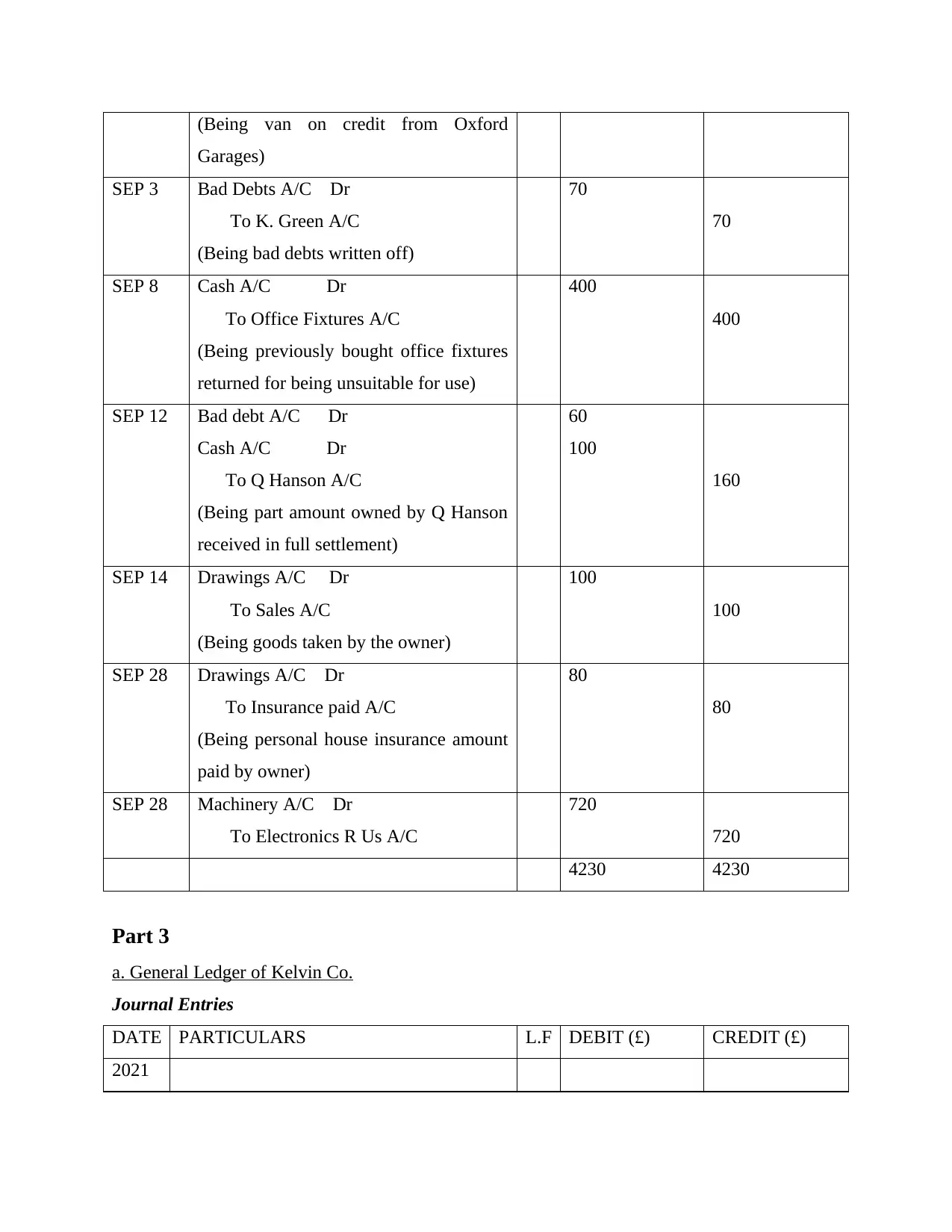
(Being van on credit from Oxford
Garages)
SEP 3 Bad Debts A/C Dr
To K. Green A/C
(Being bad debts written off)
70
70
SEP 8 Cash A/C Dr
To Office Fixtures A/C
(Being previously bought office fixtures
returned for being unsuitable for use)
400
400
SEP 12 Bad debt A/C Dr
Cash A/C Dr
To Q Hanson A/C
(Being part amount owned by Q Hanson
received in full settlement)
60
100
160
SEP 14 Drawings A/C Dr
To Sales A/C
(Being goods taken by the owner)
100
100
SEP 28 Drawings A/C Dr
To Insurance paid A/C
(Being personal house insurance amount
paid by owner)
80
80
SEP 28 Machinery A/C Dr
To Electronics R Us A/C
720
720
4230 4230
Part 3
a. General Ledger of Kelvin Co.
Journal Entries
DATE PARTICULARS L.F DEBIT (£) CREDIT (£)
2021
Garages)
SEP 3 Bad Debts A/C Dr
To K. Green A/C
(Being bad debts written off)
70
70
SEP 8 Cash A/C Dr
To Office Fixtures A/C
(Being previously bought office fixtures
returned for being unsuitable for use)
400
400
SEP 12 Bad debt A/C Dr
Cash A/C Dr
To Q Hanson A/C
(Being part amount owned by Q Hanson
received in full settlement)
60
100
160
SEP 14 Drawings A/C Dr
To Sales A/C
(Being goods taken by the owner)
100
100
SEP 28 Drawings A/C Dr
To Insurance paid A/C
(Being personal house insurance amount
paid by owner)
80
80
SEP 28 Machinery A/C Dr
To Electronics R Us A/C
720
720
4230 4230
Part 3
a. General Ledger of Kelvin Co.
Journal Entries
DATE PARTICULARS L.F DEBIT (£) CREDIT (£)
2021
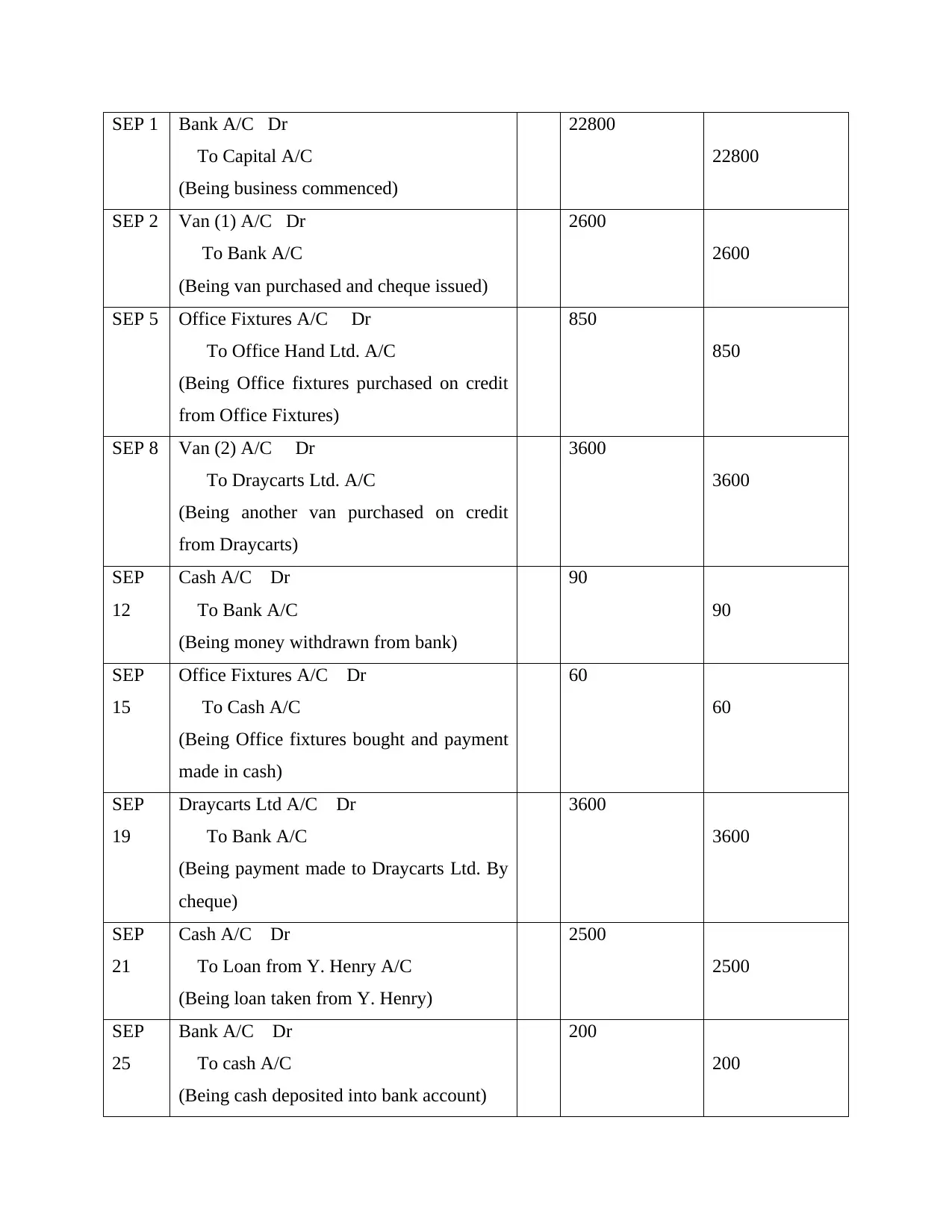
SEP 1 Bank A/C Dr
To Capital A/C
(Being business commenced)
22800
22800
SEP 2 Van (1) A/C Dr
To Bank A/C
(Being van purchased and cheque issued)
2600
2600
SEP 5 Office Fixtures A/C Dr
To Office Hand Ltd. A/C
(Being Office fixtures purchased on credit
from Office Fixtures)
850
850
SEP 8 Van (2) A/C Dr
To Draycarts Ltd. A/C
(Being another van purchased on credit
from Draycarts)
3600
3600
SEP
12
Cash A/C Dr
To Bank A/C
(Being money withdrawn from bank)
90
90
SEP
15
Office Fixtures A/C Dr
To Cash A/C
(Being Office fixtures bought and payment
made in cash)
60
60
SEP
19
Draycarts Ltd A/C Dr
To Bank A/C
(Being payment made to Draycarts Ltd. By
cheque)
3600
3600
SEP
21
Cash A/C Dr
To Loan from Y. Henry A/C
(Being loan taken from Y. Henry)
2500
2500
SEP
25
Bank A/C Dr
To cash A/C
(Being cash deposited into bank account)
200
200
To Capital A/C
(Being business commenced)
22800
22800
SEP 2 Van (1) A/C Dr
To Bank A/C
(Being van purchased and cheque issued)
2600
2600
SEP 5 Office Fixtures A/C Dr
To Office Hand Ltd. A/C
(Being Office fixtures purchased on credit
from Office Fixtures)
850
850
SEP 8 Van (2) A/C Dr
To Draycarts Ltd. A/C
(Being another van purchased on credit
from Draycarts)
3600
3600
SEP
12
Cash A/C Dr
To Bank A/C
(Being money withdrawn from bank)
90
90
SEP
15
Office Fixtures A/C Dr
To Cash A/C
(Being Office fixtures bought and payment
made in cash)
60
60
SEP
19
Draycarts Ltd A/C Dr
To Bank A/C
(Being payment made to Draycarts Ltd. By
cheque)
3600
3600
SEP
21
Cash A/C Dr
To Loan from Y. Henry A/C
(Being loan taken from Y. Henry)
2500
2500
SEP
25
Bank A/C Dr
To cash A/C
(Being cash deposited into bank account)
200
200
Paraphrase This Document
Need a fresh take? Get an instant paraphrase of this document with our AI Paraphraser
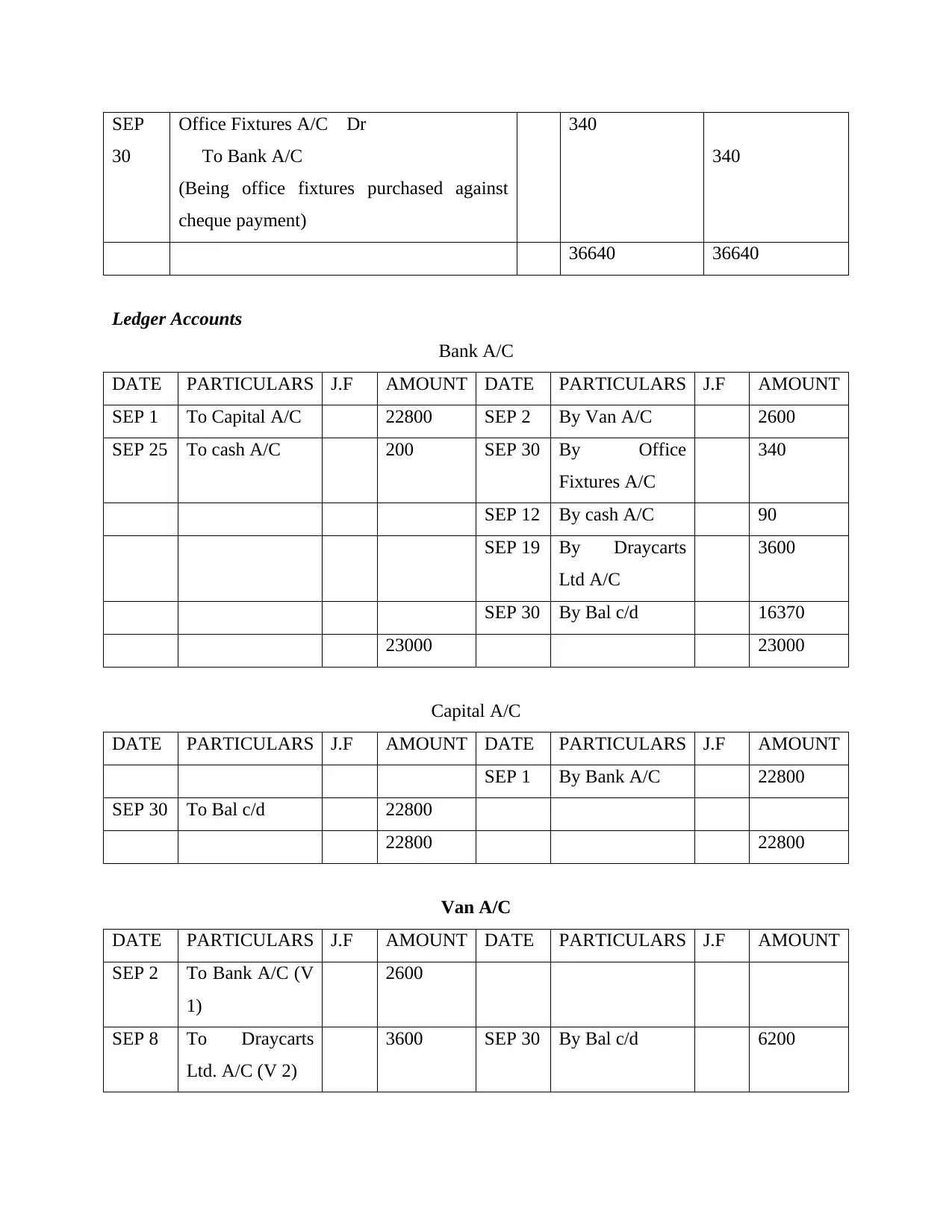
SEP
30
Office Fixtures A/C Dr
To Bank A/C
(Being office fixtures purchased against
cheque payment)
340
340
36640 36640
Ledger Accounts
Bank A/C
DATE PARTICULARS J.F AMOUNT DATE PARTICULARS J.F AMOUNT
SEP 1 To Capital A/C 22800 SEP 2 By Van A/C 2600
SEP 25 To cash A/C 200 SEP 30 By Office
Fixtures A/C
340
SEP 12 By cash A/C 90
SEP 19 By Draycarts
Ltd A/C
3600
SEP 30 By Bal c/d 16370
23000 23000
Capital A/C
DATE PARTICULARS J.F AMOUNT DATE PARTICULARS J.F AMOUNT
SEP 1 By Bank A/C 22800
SEP 30 To Bal c/d 22800
22800 22800
Van A/C
DATE PARTICULARS J.F AMOUNT DATE PARTICULARS J.F AMOUNT
SEP 2 To Bank A/C (V
1)
2600
SEP 8 To Draycarts
Ltd. A/C (V 2)
3600 SEP 30 By Bal c/d 6200
30
Office Fixtures A/C Dr
To Bank A/C
(Being office fixtures purchased against
cheque payment)
340
340
36640 36640
Ledger Accounts
Bank A/C
DATE PARTICULARS J.F AMOUNT DATE PARTICULARS J.F AMOUNT
SEP 1 To Capital A/C 22800 SEP 2 By Van A/C 2600
SEP 25 To cash A/C 200 SEP 30 By Office
Fixtures A/C
340
SEP 12 By cash A/C 90
SEP 19 By Draycarts
Ltd A/C
3600
SEP 30 By Bal c/d 16370
23000 23000
Capital A/C
DATE PARTICULARS J.F AMOUNT DATE PARTICULARS J.F AMOUNT
SEP 1 By Bank A/C 22800
SEP 30 To Bal c/d 22800
22800 22800
Van A/C
DATE PARTICULARS J.F AMOUNT DATE PARTICULARS J.F AMOUNT
SEP 2 To Bank A/C (V
1)
2600
SEP 8 To Draycarts
Ltd. A/C (V 2)
3600 SEP 30 By Bal c/d 6200

6200 6200
Office Fixtures A/C
DATE PARTICULARS J.F AMOUNT DATE PARTICULARS J.F AMOUNT
SEP 5 To Office Hand
Ltd. A/C
850
SEP 15 To Cash A/C 60
SEP 30 To Bank A/C 340 SEP 30 By Bal c/d 1250
1250 1250
Office Hand Ltd. A/C
DATE PARTICULARS J.F AMOUNT DATE PARTICULARS J.F AMOUNT
SEP 30 To Bal c/d 850 SEP 5 By Office
Fixtures A/C
850
850 850
Draycarts Ltd. A/C
DATE PARTICULARS J.F AMOUNT DATE PARTICULARS J.F AMOUNT
SEP 19 To Bank A/C 3600 SEP 8 By Van A/C 3600
3600 3600
Cash A/C
DATE PARTICULARS J.F AMOUNT DATE PARTICULARS J.F AMOUNT
SEP 12 To bank A/C 90 SEP 15 By Office
Fixtures A/C
60
SEP 21 To Loan from Y.
Henry A/C
2500 SEP 25 By Bank A/C 200
SEP 30 By Bal c/d 2330
2590 2590
Loan from Y. Henry A/C
Office Fixtures A/C
DATE PARTICULARS J.F AMOUNT DATE PARTICULARS J.F AMOUNT
SEP 5 To Office Hand
Ltd. A/C
850
SEP 15 To Cash A/C 60
SEP 30 To Bank A/C 340 SEP 30 By Bal c/d 1250
1250 1250
Office Hand Ltd. A/C
DATE PARTICULARS J.F AMOUNT DATE PARTICULARS J.F AMOUNT
SEP 30 To Bal c/d 850 SEP 5 By Office
Fixtures A/C
850
850 850
Draycarts Ltd. A/C
DATE PARTICULARS J.F AMOUNT DATE PARTICULARS J.F AMOUNT
SEP 19 To Bank A/C 3600 SEP 8 By Van A/C 3600
3600 3600
Cash A/C
DATE PARTICULARS J.F AMOUNT DATE PARTICULARS J.F AMOUNT
SEP 12 To bank A/C 90 SEP 15 By Office
Fixtures A/C
60
SEP 21 To Loan from Y.
Henry A/C
2500 SEP 25 By Bank A/C 200
SEP 30 By Bal c/d 2330
2590 2590
Loan from Y. Henry A/C
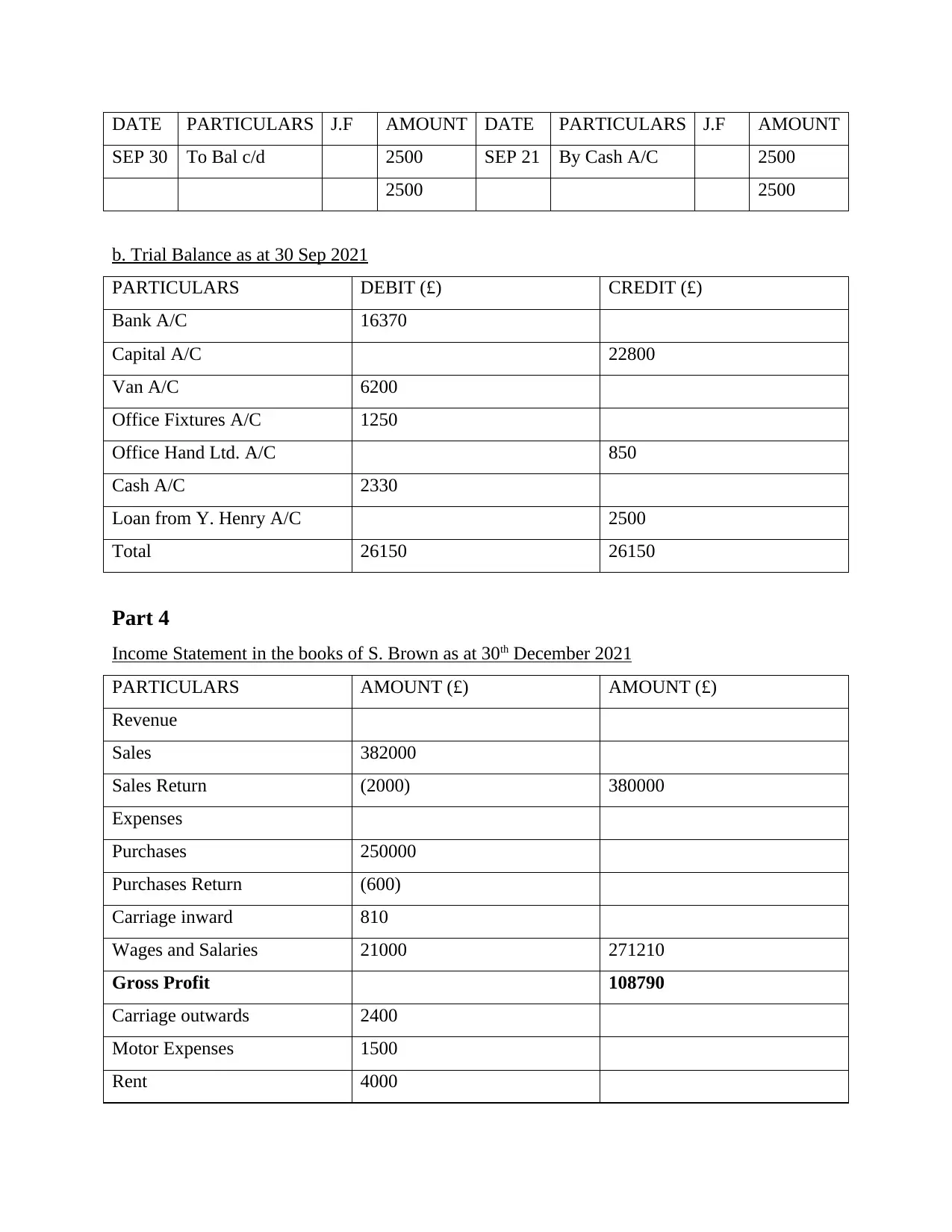
DATE PARTICULARS J.F AMOUNT DATE PARTICULARS J.F AMOUNT
SEP 30 To Bal c/d 2500 SEP 21 By Cash A/C 2500
2500 2500
b. Trial Balance as at 30 Sep 2021
PARTICULARS DEBIT (£) CREDIT (£)
Bank A/C 16370
Capital A/C 22800
Van A/C 6200
Office Fixtures A/C 1250
Office Hand Ltd. A/C 850
Cash A/C 2330
Loan from Y. Henry A/C 2500
Total 26150 26150
Part 4
Income Statement in the books of S. Brown as at 30th December 2021
PARTICULARS AMOUNT (£) AMOUNT (£)
Revenue
Sales 382000
Sales Return (2000) 380000
Expenses
Purchases 250000
Purchases Return (600)
Carriage inward 810
Wages and Salaries 21000 271210
Gross Profit 108790
Carriage outwards 2400
Motor Expenses 1500
Rent 4000
SEP 30 To Bal c/d 2500 SEP 21 By Cash A/C 2500
2500 2500
b. Trial Balance as at 30 Sep 2021
PARTICULARS DEBIT (£) CREDIT (£)
Bank A/C 16370
Capital A/C 22800
Van A/C 6200
Office Fixtures A/C 1250
Office Hand Ltd. A/C 850
Cash A/C 2330
Loan from Y. Henry A/C 2500
Total 26150 26150
Part 4
Income Statement in the books of S. Brown as at 30th December 2021
PARTICULARS AMOUNT (£) AMOUNT (£)
Revenue
Sales 382000
Sales Return (2000) 380000
Expenses
Purchases 250000
Purchases Return (600)
Carriage inward 810
Wages and Salaries 21000 271210
Gross Profit 108790
Carriage outwards 2400
Motor Expenses 1500
Rent 4000
Secure Best Marks with AI Grader
Need help grading? Try our AI Grader for instant feedback on your assignments.

Telephone Charges 540
Insurance 750
Office Expenses 50400
Sundry Expenses 20200 79790
Net Profit 29000
Insurance 750
Office Expenses 50400
Sundry Expenses 20200 79790
Net Profit 29000
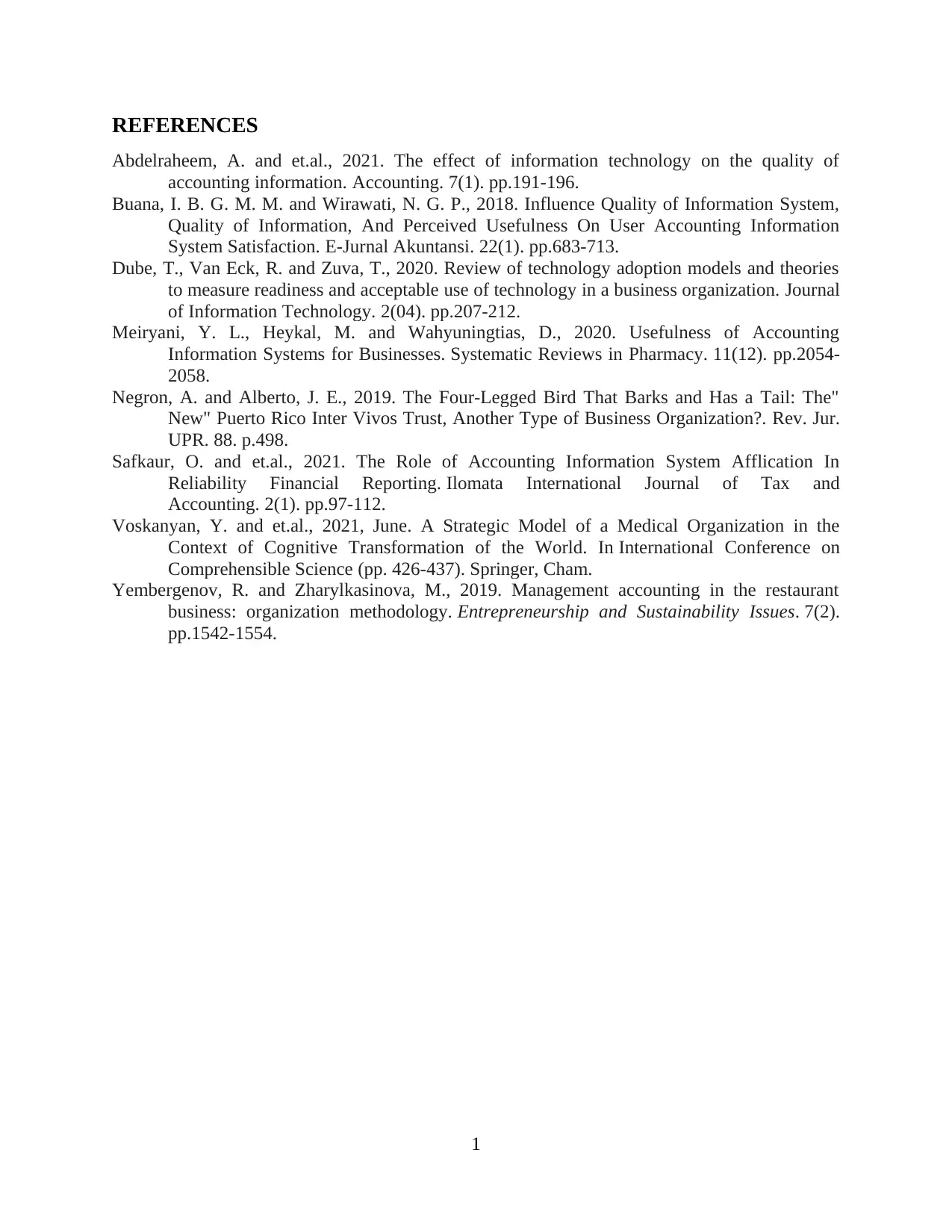
REFERENCES
Abdelraheem, A. and et.al., 2021. The effect of information technology on the quality of
accounting information. Accounting. 7(1). pp.191-196.
Buana, I. B. G. M. M. and Wirawati, N. G. P., 2018. Influence Quality of Information System,
Quality of Information, And Perceived Usefulness On User Accounting Information
System Satisfaction. E-Jurnal Akuntansi. 22(1). pp.683-713.
Dube, T., Van Eck, R. and Zuva, T., 2020. Review of technology adoption models and theories
to measure readiness and acceptable use of technology in a business organization. Journal
of Information Technology. 2(04). pp.207-212.
Meiryani, Y. L., Heykal, M. and Wahyuningtias, D., 2020. Usefulness of Accounting
Information Systems for Businesses. Systematic Reviews in Pharmacy. 11(12). pp.2054-
2058.
Negron, A. and Alberto, J. E., 2019. The Four-Legged Bird That Barks and Has a Tail: The"
New" Puerto Rico Inter Vivos Trust, Another Type of Business Organization?. Rev. Jur.
UPR. 88. p.498.
Safkaur, O. and et.al., 2021. The Role of Accounting Information System Afflication In
Reliability Financial Reporting. Ilomata International Journal of Tax and
Accounting. 2(1). pp.97-112.
Voskanyan, Y. and et.al., 2021, June. A Strategic Model of a Medical Organization in the
Context of Cognitive Transformation of the World. In International Conference on
Comprehensible Science (pp. 426-437). Springer, Cham.
Yembergenov, R. and Zharylkasinova, М., 2019. Management accounting in the restaurant
business: organization methodology. Entrepreneurship and Sustainability Issues. 7(2).
pp.1542-1554.
1
Abdelraheem, A. and et.al., 2021. The effect of information technology on the quality of
accounting information. Accounting. 7(1). pp.191-196.
Buana, I. B. G. M. M. and Wirawati, N. G. P., 2018. Influence Quality of Information System,
Quality of Information, And Perceived Usefulness On User Accounting Information
System Satisfaction. E-Jurnal Akuntansi. 22(1). pp.683-713.
Dube, T., Van Eck, R. and Zuva, T., 2020. Review of technology adoption models and theories
to measure readiness and acceptable use of technology in a business organization. Journal
of Information Technology. 2(04). pp.207-212.
Meiryani, Y. L., Heykal, M. and Wahyuningtias, D., 2020. Usefulness of Accounting
Information Systems for Businesses. Systematic Reviews in Pharmacy. 11(12). pp.2054-
2058.
Negron, A. and Alberto, J. E., 2019. The Four-Legged Bird That Barks and Has a Tail: The"
New" Puerto Rico Inter Vivos Trust, Another Type of Business Organization?. Rev. Jur.
UPR. 88. p.498.
Safkaur, O. and et.al., 2021. The Role of Accounting Information System Afflication In
Reliability Financial Reporting. Ilomata International Journal of Tax and
Accounting. 2(1). pp.97-112.
Voskanyan, Y. and et.al., 2021, June. A Strategic Model of a Medical Organization in the
Context of Cognitive Transformation of the World. In International Conference on
Comprehensible Science (pp. 426-437). Springer, Cham.
Yembergenov, R. and Zharylkasinova, М., 2019. Management accounting in the restaurant
business: organization methodology. Entrepreneurship and Sustainability Issues. 7(2).
pp.1542-1554.
1
1 out of 12
Related Documents
Your All-in-One AI-Powered Toolkit for Academic Success.
+13062052269
info@desklib.com
Available 24*7 on WhatsApp / Email
![[object Object]](/_next/static/media/star-bottom.7253800d.svg)
Unlock your academic potential
© 2024 | Zucol Services PVT LTD | All rights reserved.




